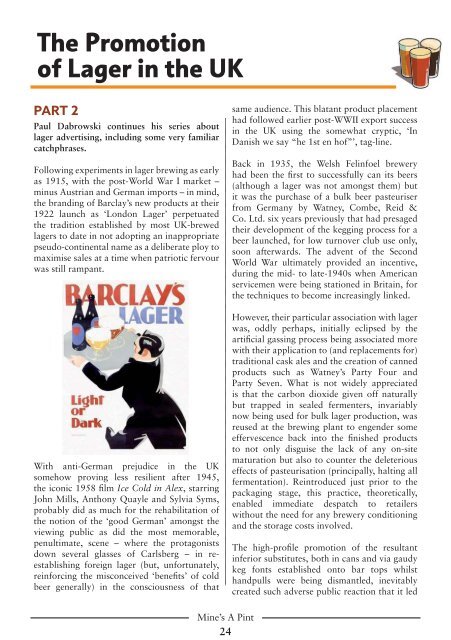Mine's a Pint - Autumn 2019
The Autumn 2019 edition of the magazine of the Reading & Mid-Berkshire Branch of the Campaign for Real Ale (CAMRA).
The Autumn 2019 edition of the magazine of the Reading & Mid-Berkshire Branch of the Campaign for Real Ale (CAMRA).
Create successful ePaper yourself
Turn your PDF publications into a flip-book with our unique Google optimized e-Paper software.
The Promotion<br />
of Lager in the UK<br />
PART 2<br />
Paul Dabrowski continues his series about<br />
lager advertising, including some very familiar<br />
catchphrases.<br />
Following experiments in lager brewing as early<br />
as 1915, with the post-World War I market –<br />
minus Austrian and German imports – in mind,<br />
the branding of Barclay’s new products at their<br />
1922 launch as ‘London Lager’ perpetuated<br />
the tradition established by most UK-brewed<br />
lagers to date in not adopting an inappropriate<br />
pseudo-continental name as a deliberate ploy to<br />
maximise sales at a time when patriotic fervour<br />
was still rampant.<br />
With anti-German prejudice in the UK<br />
somehow proving less resilient after 1945,<br />
the iconic 1958 film Ice Cold in Alex, starring<br />
John Mills, Anthony Quayle and Sylvia Syms,<br />
probably did as much for the rehabilitation of<br />
the notion of the ‘good German’ amongst the<br />
viewing public as did the most memorable,<br />
penultimate, scene – where the protagonists<br />
down several glasses of Carlsberg – in reestablishing<br />
foreign lager (but, unfortunately,<br />
reinforcing the misconceived ‘benefits’ of cold<br />
beer generally) in the consciousness of that<br />
same audience. This blatant product placement<br />
had followed earlier post-WWII export success<br />
in the UK using the somewhat cryptic, ‘In<br />
Danish we say “he 1st en hof”’, tag-line.<br />
Back in 1935, the Welsh Felinfoel brewery<br />
had been the first to successfully can its beers<br />
(although a lager was not amongst them) but<br />
it was the purchase of a bulk beer pasteuriser<br />
from Germany by Watney, Combe, Reid &<br />
Co. Ltd. six years previously that had presaged<br />
their development of the kegging process for a<br />
beer launched, for low turnover club use only,<br />
soon afterwards. The advent of the Second<br />
World War ultimately provided an incentive,<br />
during the mid- to late-1940s when American<br />
servicemen were being stationed in Britain, for<br />
the techniques to become increasingly linked.<br />
However, their particular association with lager<br />
was, oddly perhaps, initially eclipsed by the<br />
artificial gassing process being associated more<br />
with their application to (and replacements for)<br />
traditional cask ales and the creation of canned<br />
products such as Watney’s Party Four and<br />
Party Seven. What is not widely appreciated<br />
is that the carbon dioxide given off naturally<br />
but trapped in sealed fermenters, invariably<br />
now being used for bulk lager production, was<br />
reused at the brewing plant to engender some<br />
effervescence back into the finished products<br />
to not only disguise the lack of any on-site<br />
maturation but also to counter the deleterious<br />
effects of pasteurisation (principally, halting all<br />
fermentation). Reintroduced just prior to the<br />
packaging stage, this practice, theoretically,<br />
enabled immediate despatch to retailers<br />
without the need for any brewery conditioning<br />
and the storage costs involved.<br />
The high-profile promotion of the resultant<br />
inferior substitutes, both in cans and via gaudy<br />
keg fonts established onto bar tops whilst<br />
handpulls were being dismantled, inevitably<br />
created such adverse public reaction that it led<br />
Mine’s A <strong>Pint</strong><br />
24

















